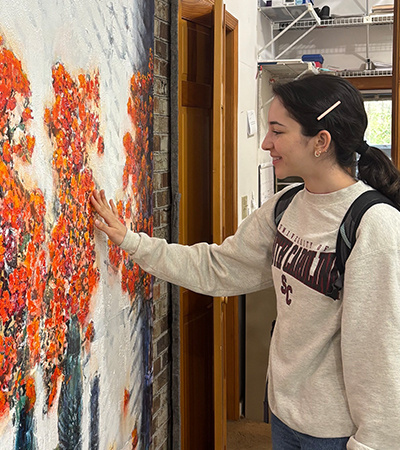When visitors walk into Generations: 100 Years of Art at USC at the McKissick Museum, they are not just stepping into a story of faculty and alumni legacies — they’re also seeing history through the eyes of current students.
Part of the School of Visual Art and Design (SVAD) centennial celebrations, the exhibition was developed in an exhibition design course taught by McKissick Museum director Lana Burgess. Students researched, curated and pieced together narratives that span from the founding of USC’s art department in 1925 to its present-day role as the state’s largest and most comprehensive art program.
For junior art history major Agostina Mercado, helping curate the centennial exhibition was both a challenge and a chance to connect with SVAD’s earliest roots. The course did more than illuminate history, however. It gave her experience that will shape her future. She conducted an oral history with longtime SVAD faculty member Philip Mullen, discovering a love for talking with artists that she says may steer her toward a museum career.
Art is powerful because it’s so human.
—Agostina Mercado
She and her classmates sifted through records across the McKissick Museum and the South Caroliniana and Thomas Cooper libraries to reconstruct key turning points in the school's evolution. Her research focused on the school’s founding under Katherine Heyward, who in 1925 launched USC’s art department as a one-woman operation.
“One of our biggest challenges was bringing together the wealth of material available to us,” Mercado says. “But that’s also what made it rewarding — uncovering the themes of history and understanding its origins.”
That history, she explained, reveals a long tradition of community ties and student-faculty rapport that still define SVAD today.

“What stood out to me is the strong bond between mentors and students,” she says. “There’s a common thread of passion that connects the faculty to the students.”
Mercado and her classmates worked alongside Burgess and co-curator Susan Felleman. Watching students take ownership of the project was especially rewarding, says Felleman.
“It was especially gratifying to see members of the research team initiating oral history interviews with former faculty and students,” she says. “Hopefully, seeing evidence of growth, change and generations of creative and cultural accomplishments over the previous century may inspire some of our current students.”
Burgess, a SVAD graduate and joint-appointed faculty member, says it was that focus on mentorship that shaped the direction of the exhibition. For example, Catharine Rembert was one of Heyward’s students and among the art department’s first graduates. She later taught art at USC for 40 years. Rembert was a mentor to Jasper Johns, who became a celebrated painter and sculptor.
“How do we honor the students and the faculty that were significant over the last 100 years?” Burgess asked. “Jasper Johns is a notable figure, but this exhibition also honors the mentors, like Catharine Rembert, whose teaching and guidance had a lasting influence on students and the school as a whole.”
As SVAD enters its second century, Generations captures the cycles of creativity that define the school — students learning from mentors, making their mark and then leaving behind a legacy for the next generation. For Mercado and her peers, contributing to the centennial exhibition was both a chance to honor that tradition and a way to step into it.
Generations will be on view at the McKissick Museum September 2-December 6, 2025.
